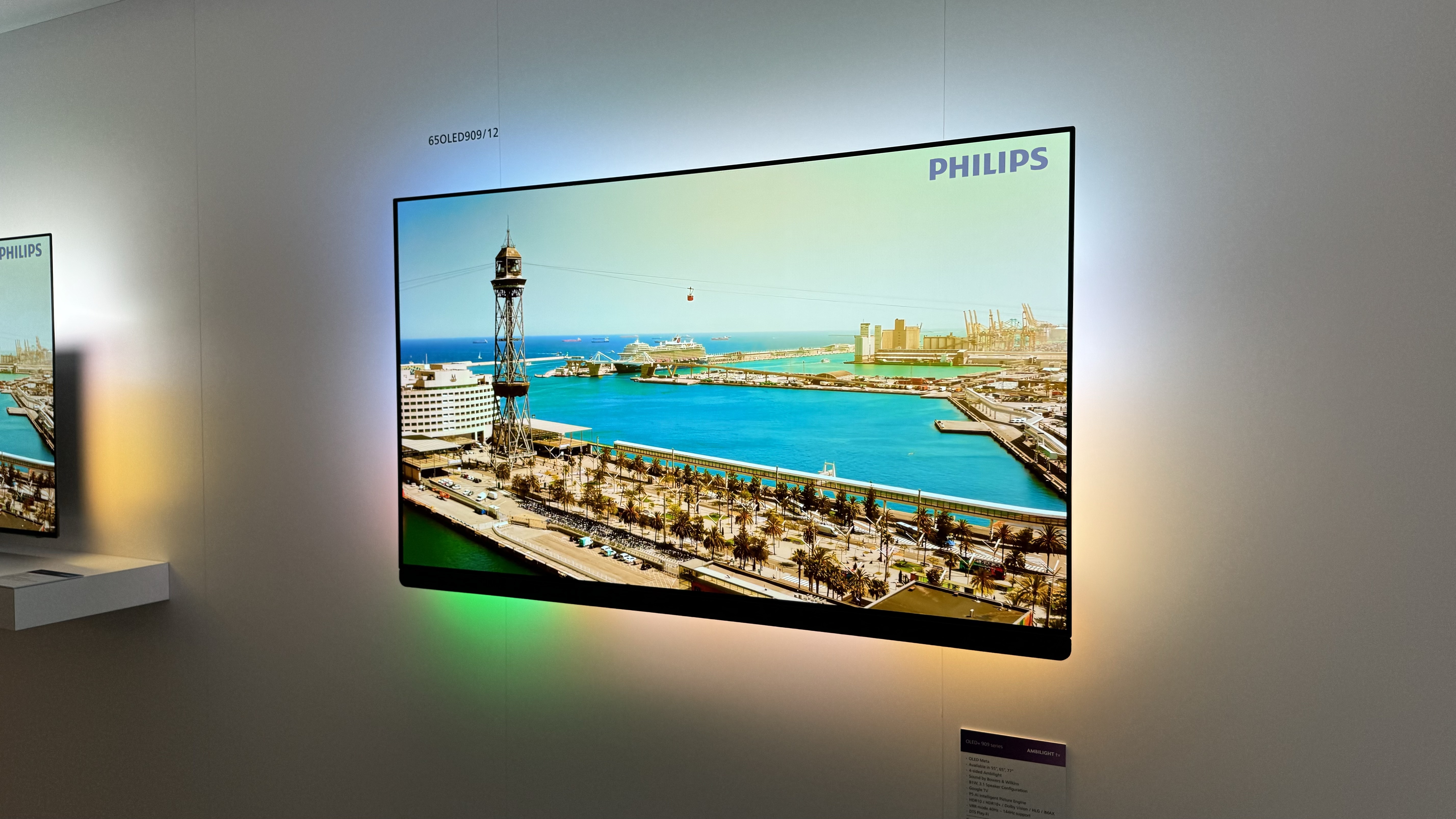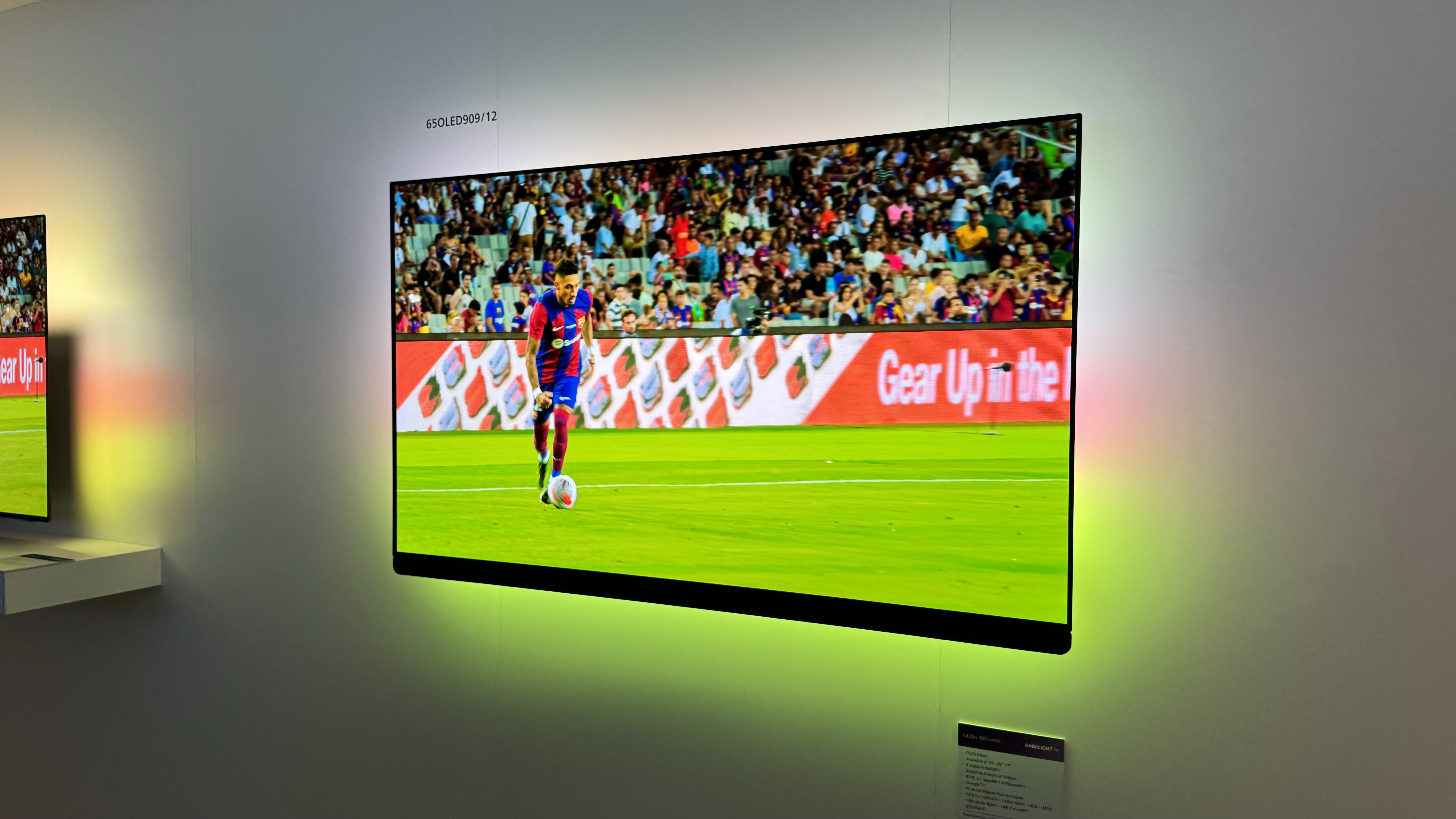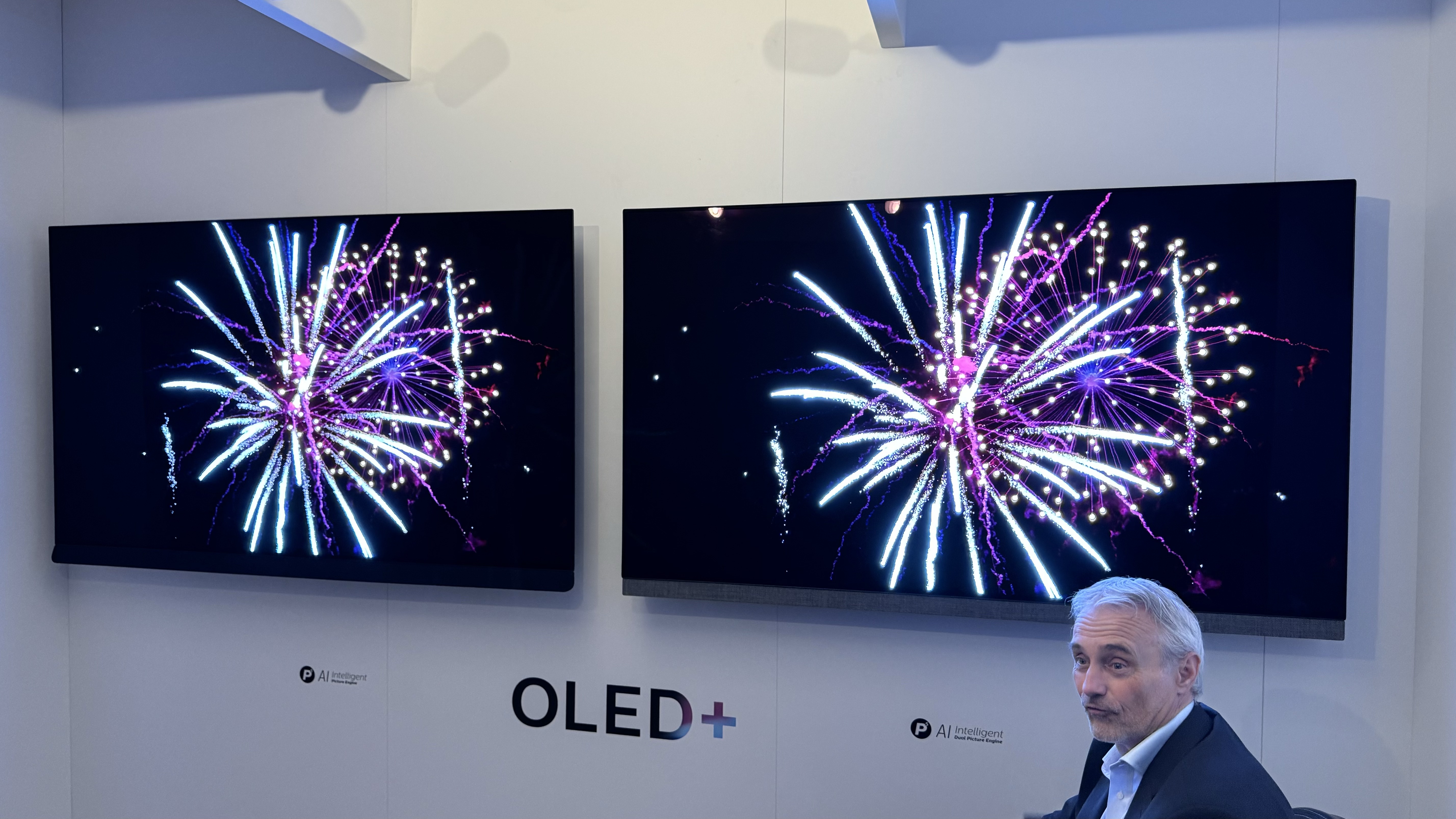
While the middle child often has a tough go of things, the middle model in Philips’ new OLED TV range might just be the pick of the litter. Dubbed OLED909 (or OLED+909), this model improves on the ‘core’ OLED809 model through the addition of brightness-boosting MLA tech (second-gen MLA, in fact) and a Bowers & Wilkins sound system, but it does without the attractive-but-niche floor-standing design of the OLED959, making it more suitable for more people.
Can it do enough to rise above rivals such as the also freshly announced LG G4 and Samsung S95D? We will need to wait until we have a production sample in our dedicated test rooms for a full, independent review before we can say for sure, but it certainly looked like a strong contender when we went hands-on with it at the recent launch event in Barcelona.
Price and availability
Just like its rivals, Philips hasn’t yet revealed pricing for its 2024 TVs, but the OLED909 will likely launch at a similar price to its OLED908 predecessor. That TV started out at £2999 for the 55-inch model, went up to £3499 for the 65-incher, and topped out at £4999 for the 77-inch version. We expect the LG G4 and Samsung S95D to be priced similarly, and it is against those models that the Philips OLED909 will almost certainly be judged.
Philips says that the OLED909 will be available in June, but it is worth pointing out that the brand has something of a reputation for getting its TVs into shops later than intended, with last year having been a particularly notable example. Here’s hoping the OLED909 and its siblings arrive in time to be considered in the What Hi-Fi? Awards, which will be announced in October.
Design

While beauty is very much in the eye of the beholder and there are limits to how creative a brand can get with a TV’s design – seeing that it is primarily a slab of screen – I still think the Philips OLED909 is one of the most handsome TVs around. The smart, Kvadrat-covered speaker bar is a little slimmer than before and no longer juts out like Bruce Forsyth’s chin, making the whole set look a little more subtle and classy. Materials look and feel premium, and the dainty feet are as unobtrusive as can be – though they do also rob the set of the swivel functionality that last year’s pedestal-mounted model had.
While it doesn’t get the new ‘Ambilight Plus’ version of Philips’ Ambilight system (that’s reserved for the OLED959), the OLED909 does mark the return of four-sided Ambilight, so that coloured light (that matches the on-screen action or provides more simple bias lighting) emanates from the bottom edge as well as the top and sides. That will be a pretty big deal for Ambilight lovers who intend to wall-mount their new TV.
Features

The biggest news here is that the OLED909 features the new, second-generation MLA OLED panel from LG Display. This is the same panel that will be present in the LG G4 and Panasonic Z95A, and while those brands are being fairly coy about peak brightness figures, Philips is claiming that the OLED909 will be able to hit 3000 nits. As ever, that figure will only be possible in a small window (Philips’ own measurement comes from a white window covering 3 per cent of the screen), for a brief time and only in certain modes. Even so, that’s an almost 50 per cent increase in brightness over last year’s OLED908 MLA OLED, and the peak brightness of the more subtle and authentic picture modes should benefit from a similar increase.
Under the hood is a new 8th Gen P5 AI processor, which brings with it a new ‘Ambient Intelligence V3’ feature. This is a new level of automatic picture optimisation that specifically targets HDR impact. The idea is that it compensates for any increases in ambient light in the room, boosting HDR elements to maintain pop and punch. Philips already automatically adjusts colours and general brightness to ambient lighting conditions, so this is in theory the last piece of the puzzle. Philips says it’s essentially like Dolby Vision IQ, but it works across all HDR formats. Speaking of which, as has long been the case with Philips TVs, the OLED909 supports HLG, HDR10, HDR10+ and Dolby Vision, so all bases are covered.
The 8th Gen P5 AI also features ‘Improved Smart Bit Enhancement’, which is designed to reduce banding in very low-quality sources while maintaining detail, and ‘Enhanced HDR Tonemapping’, which analyses and optimises each frame to maximise contrast without introducing ‘clipping’ (loss of detail and shading in bright picture elements).
Philips is launching a number of TVs this year that use a new operating system, called Titan, but the OLED909 isn’t one of them. It (plus the OLED809 and OLED959) are instead sticking with Google TV. Philips’ Google TVs from last year were lacking the UK’s terrestrial channel catch-up apps, so it will be interesting to see whether Philips (or indeed Google) can overcome that issue ahead of the release of this year’s TVs. It will also be interesting to see whether the switch to Titan for some models is a precursor to a whole-range swap next year.
On the gaming front, there’s good news and bad news. The bad news is that the OLED909 (as well as the OLED809 and OLED959) still has just two HDMI 2.1 sockets – something that is made all the more frustrating by the fact that Philips’ new Titan TVs will have four. In an exclusive interview with What Hi-Fi?, Philips’ Danny Tack explained that this is down to the company’s new TV range being split between two different platforms, and that it’s essentially a choice between getting the brand’s best picture performance and getting more HDMI 2.1 sockets.
The good news is that the OLED909 will support 4K/144Hz signals, even with Dolby Vision and VRR, and that Philips has produced a new and apparently more useful version of its Game Bar, which grants instant access to various game-related features, settings and readouts. 4K/120Hz signals, which are far more useful to most gamers, are also of course supported, and so is ALLM.
As this is what Philips dubs an ‘OLED+’ model, it features a sound system by Bowers & Wilkins. This isn’t the 5.1.2 system of the OLED959, but a more subtle 3.1 affair. Even so, it has a claimed 81W of power.
Picture

Our hands-on session began with demonstrations of the new features of the 8th Gen P5 AI processor, and I was impressed. With two TVs side-by-side, the benefits of the Enhanced HDR Tone Mapping were immediately apparent, with the TV that had it switched on looking clearly more impactful, defined and vibrant.
In an image of a geyser, the Enhanced HDR Tonemapping produced a much more defined and three-dimensional cloud of steam, significantly more varied and detailed shading to the yellow and orange ground around the water, and more crisply drawn trees in the background. While much more testing will be required to be sure, it also looks as though Philips has achieved this without making the image look artificially sharpened or too vivid.
The Ambient Intelligence V3 feature looked good, too. The opening dragon scene of Thor: Ragnarok was fed into the two TVs, one of which had Ambient Intelligence V3 switched on and the other with it off. Some slight colour tone differences aside, the two TVs looked more or less identical in a dark room, but when the lights were switched on, after a few seconds of subtle adjustment, the Ambient Intelligence V3 TV had compensated and was producing a much punchier, more contrasty image that made the sample next to it look rather dull. A few seconds after the lights were switched off again, the two TVs were back to looking very similar. This is the sort of feature that’s really useful to those who watch in varied lighting conditions, but it needs to be done in such a way that it doesn’t deviate too much from the creative intent of the movie or TV show being watched. First impressions are that Philips is on the right track here.
It’s telling that the processing demos were conducted with the TVs in their Filmmaker Modes, with Philips keen to illustrate their benefits even for those who prefer a cinematically authentic picture, but for a demonstration of the OLED909’s new, brighter MLA OLED panel, the Dynamic mode was selected. Here, we saw the new model next to last year’s OLED908, with various high-contrast demo clips run on a loop, and the upgrade was obvious. The OLED908 is a very bright TV by OLED standards but bright highlights on the OLED909 leapt from the screen. Fireworks sparkled, coloured sweets dazzled and the Earth glowed brilliantly against the perfectly black background of space.
It’s not simply that the OLED909 looked brighter than its predecessor, but the way in which that brightness increases contrast, which increases definition, solidity and the sense of three-dimensionality. It was simply a much more impactful and thrilling picture.
Of course, this was with carefully selected demo footage in a room with some ambient light, and whether the benefits will be as obvious with ‘real’ content (the vast majority of which is mastered to well below 1000 nits) and in a dark room remains to be seen. That is of course something we will be testing thoroughly once we get the OLED909 in for a full review ahead of launch.
Sound

In a separate room, the B&W team treated us to a demonstration of the OLED909’s audio abilities, and this too was impressive. Playing What Was I Made For by Billie Eilish, the TV did a really good job recreating the richness, warmth and detail in the vocal, while also projecting it into the room and making it sound as if it was coming from the centre of the TV rather than the actual speaker bar attached to its bottom edge.
Switching to the embassy escape scene from Mission Impossible: Dead Reckoning Part 1, I must confess that at one point I had to remind myself to concentrate on the quality of the sound and not simply enjoy the movie. It’s obviously not up there with a true home cinema system for sound, but the way it handles the core qualities of a soundtrack is impressive. For a TV, there appeared to be very good spatial organisation and placement, solid and weighty bass, lots of detail and clear, focused dialogue. It’s too early to be sure, but I’d be surprised if this didn’t turn out to be one of the best-sounding TVs in its class.
Verdict
As ever, we will have to wait until we have a full production sample in our own test rooms for a comprehensive and comparative review before we deliver a final verdict, but the OLED909 appears at this stage to be a very good TV indeed. The new, brighter MLA OLED panel delivers significantly more impact, the new picture enhancement features look genuinely useful, even to those who value picture authenticity, and the sound system seems to be very accomplished despite its discreet design.
This is definitely one to watch this year – let’s just hope Philips can get it into shops and into our test rooms in a timely fashion.
MORE:
These are the best TVs you can buy right now
Here's everything you need to know about Micro Lens Array (MLA)
Grab a bargain with one of these TV deals







